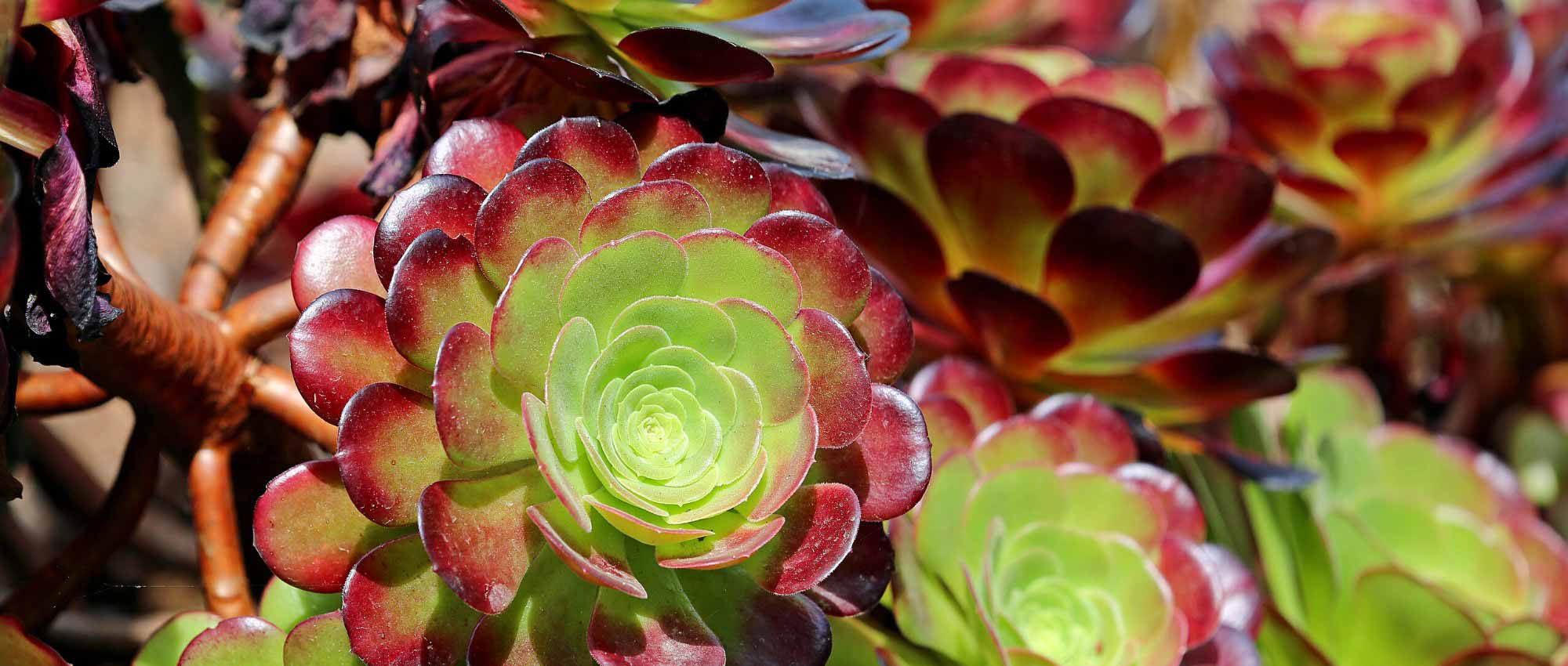
Aeonium: planting, cultivating, and care
Contents
Aeoniums in a Nutshell
- Aeoniums are succulent plants forming rosettes of imbricate leaves
- They come in a wide range of colours and shapes depending on the variety
- They often develop ramified stems, giving them the appearance of a small bush
- They should only be planted outdoors in regions unaffected by frost
- They require good light and a well-draining substrate
The word from our expert
Aeoniums are stunning succulent plants that form thick, ramified stems bearing rosettes of imbricate leaves. These rosettes are highly symmetrical, with shapes reminiscent of rosettes or spirals. They come in a beautiful palette of colours: light green, deep purple-black, red, bluish, variegated with cream or white… Graphic and highly decorative, Aeoniums integrate easily into succulent plant compositions, alongside Echeverias, sedums, or Kalanchoes, for example.
Aeoniums originate from the Canary Islands, Madeira, Cape Verde, North Africa, and the Mediterranean basin, which explains why they are not very hardy! Unless you live in a region with a very mild climate, such as the French Riviera where the risk of frost is low, you will need to grow them in pots so they can be easily moved indoors for the winter. To thrive, they require good light and a perfectly well-drained substrate, as they are sensitive to excess moisture. Discover all our tips for successfully growing Aeoniums!
Botany and description
Botanical data
- Latin name Aeonium sp.
- Family Crassulaceae
- Common name Aeonium, Tree Houseleek
- Flowering spring or summer
- Height between 15 cm and 1 m
- Sun exposure sun or partial shade
- Soil type well-drained, sandy
- Hardiness between 0 °C and – 5 °C depending on the variety
Aeoniums are stunning succulent plants forming rosettes of thick, fleshy leaves. They comprise 57 species primarily native to the Canary Islands, Madeira, Cape Verde, as well as North Africa and the Mediterranean basin. Naturally growing in these regions with very mild climates, Aeoniums are tender plants: their cultivation in open ground is best reserved for frost-free regions.
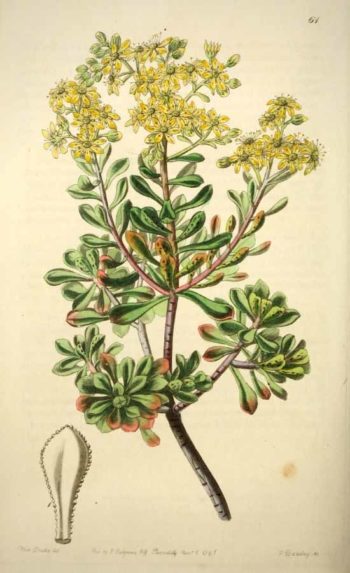
Aeonium spathulifolium: Botanical illustration
These are perennial or undershrubs that form thick, ramified stems, bearing rosettes of fleshy leaves at their tips. Some species are stemless, forming their rosettes at ground level, similar to Echeverias and Houseleeks. Aeoniums come in many varieties, offering a wide range of original colours and a beautiful diversity of forms.
Aeoniums belong to the Crassulaceae family, like most succulent plants. This family also includes Kalanchoes, Sedums, Echeverias, and Houseleeks. The latter two plants, in particular, have a form similar to Aeoniums, with imbricate leaves arranged in rosettes.
Aeoniums measure between 20 cm and 1 m in height, depending on the variety and their form: stemless species are naturally much shorter than those with ramified stems. When grown in open ground in a mild climate, the Aeonium arboreum can even reach up to 2 m in height.
Aeoniums have evergreen foliage, remaining decorative all year round. Their fleshy leaves allow them to store water and minerals, enabling them to survive periods of drought.
The leaves are spatulate and imbricate. Generally, they are inserted more sparsely than in Echeverias and Sedums, with space between each leaf in the same rank, forming less dense rosettes.
The leaves of Aeoniums take on different colours depending on the variety: they can be green, red, purple, or black-brown… When the rosettes are red or purple, they are often light green at the centre, creating a lovely contrast. Some varieties are variegated: for example, the Aeonium arboreum ‘Albovariegatum’, with green leaves margined in creamy white, and the Aeonium occidentale, with leaves delicately striated in dark red.

Aeoniums display different colours depending on the variety! Aeonium arboreum ‘Atropurpureum’, Aeonium ‘Bing Thing’, Aeonium arboreum ‘Albovariegatum’ and Aeonium haworthii (photo: Michael Wolf)
The shape of the rosettes also varies by variety. The Aeonium tabuliforme is very unique: it forms flattened rosettes, composed of numerous densely imbricate leaves arranged regularly in a quincunx pattern, creating a very harmonious rosette! The Aeonium sediforme, on the other hand, has small leaves reminiscent of Sedums!
Aeoniums flower in spring or summer. They then produce a long floral stem emerging from the centre of the rosette, bearing a dense, pyramidal panicle composed of numerous star-shaped flowers, usually yellow, sometimes creamy white, pink, or orange. Small in size, the flowers measure between 8 and 15 mm in diameter. They consist of 7 to 12 fine, radiating petals surrounding the stamens and pistil. In varieties with dark foliage, such as ‘Schwarzkopf’, the yellow flowering creates a stunning contrast!
After flowering, the rosette that bore the flowers dies, but it is replaced by other rosettes on the plant (in plants with multiple rosettes; if the rosette is unique, the plant dies completely).

The yellow flowering of Aeonium arboreum: inflorescence and flower detail (photos: Leighklotz / Kenpei), the white flowers of Aeonium canariense and pink flowers of Aeonium urbicum (photo: Gabriele Kothe-Heinrich)
Read also
Propagating cacti and succulentsThe main varieties of Aeoniums
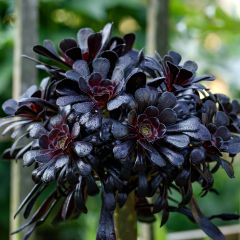
Aeonium arboreum var. atropurpureum Schwarzkopf
- Flowering time May, June
- Height at maturity 80 cm

Aeonium arboreum Cornish Tribute
- Height at maturity 25 cm
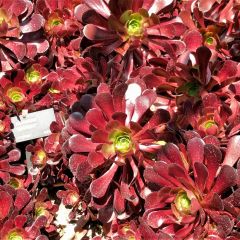
Aeonium arboreum Garnet
- Flowering time May to July
- Height at maturity 1 m
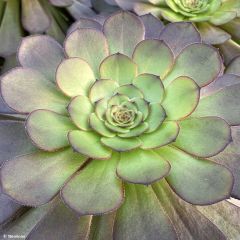
Aeonium arboreum Tip Top
- Flowering time June, July
- Height at maturity 30 cm
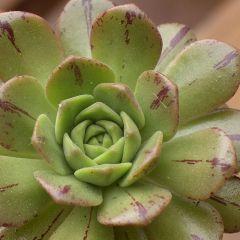
Aeonium occidentale
- Flowering time June
- Height at maturity 20 cm
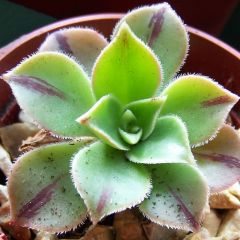
Aeonium leucoblepharum
- Flowering time June
- Height at maturity 75 cm
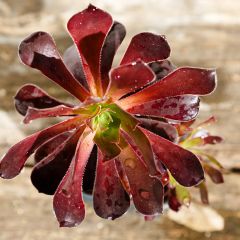
Aeonium arboreum Du Rozzen
- Height at maturity 40 cm
Discover other Cacti and succulents
View all →Available in 0 sizes
Available in 1 sizes
Available in 1 sizes
Available in 1 sizes
Available in 1 sizes
Available in 1 sizes
Available in 1 sizes
Available in 1 sizes
Available in 1 sizes
Available in 1 sizes
Planting Aeoniums
Where to Plant?
Aeonium is a frost-sensitive plant: it can only be grown outdoors in regions unaffected by frost, particularly in the Mediterranean basin. It will thrive in a rock garden or a dry exotic garden, alongside other succulents, cacti, agaves, and yuccas. In other parts of the country, it should be grown in a pot so it can be brought indoors during winter.
Aeoniums prefer full sun or partial shade and require well-drained soil, even rocky or sandy, as they dislike stagnant moisture. If planted outdoors, place them in a rock garden or a dry, mineral-rich garden. Ideally, position them on higher ground (such as a mound or slope) rather than in a depression where water might collect.
Varieties with red or purple foliage will appreciate a sunny spot, as this enhances their colour, while those with lighter foliage, such as those variegated with cream-yellow or white, prefer partial shade, as full sun may scorch their leaves.
If you grow Aeonium in a pot, place it ideally in a conservatory, greenhouse, or indoors near a window to ensure good light exposure. If it lacks light, it may become leggy. Be cautious—Aeoniums dislike overheated interiors, so avoid placing them near radiators.
When to Plant?
If planting outdoors, we recommend planting Aeonium in spring, around May, as temperatures will be more favourable for its establishment. Repotting is also best done in spring.
How to Plant?
Outdoors:
- Dig a planting hole at least twice the size of the root ball.
- Replace some soil at the bottom of the hole, mixed with coarse sand.
- Gently remove the Aeonium from its pot and place it in the centre of the planting hole.
- Fill in around it with soil, then lightly firm it down.
- Water.
- You can add a thin layer of mineral mulch, such as gravel, around the Aeonium: this is decorative and also helps isolate the collar and basal leaves from the moisture of the compost.
→ Also read: How to plant succulents outdoors in the garden?
In a Pot:
We recommend choosing a terracotta pot, as it provides better root aeration and drainage than a plastic pot. This reduces the risk of root rot due to excess moisture. Alternatively, a plastic pot will also work, but you will need to water less frequently. In any case, the pot must have drainage holes at the bottom to allow excess water to escape.
For pot cultivation, we advise using a mix of one-third compost, one-third coarse non-calcareous sand, and one-third gravel, pumice, or perlite.
- Place a layer of gravel or clay pebbles at the bottom of the pot for drainage.
- Add some of the substrate, such as a mix of compost, coarse sand, and pumice, or specialised cactus compost.
- Place the Aeonium in the centre of the pot.
- Fill in around it with substrate, then lightly firm it down.
- Water.
- We recommend adding a thin layer of coarse sand or small gravel on the surface to isolate the basal leaves from the moisture of the compost.
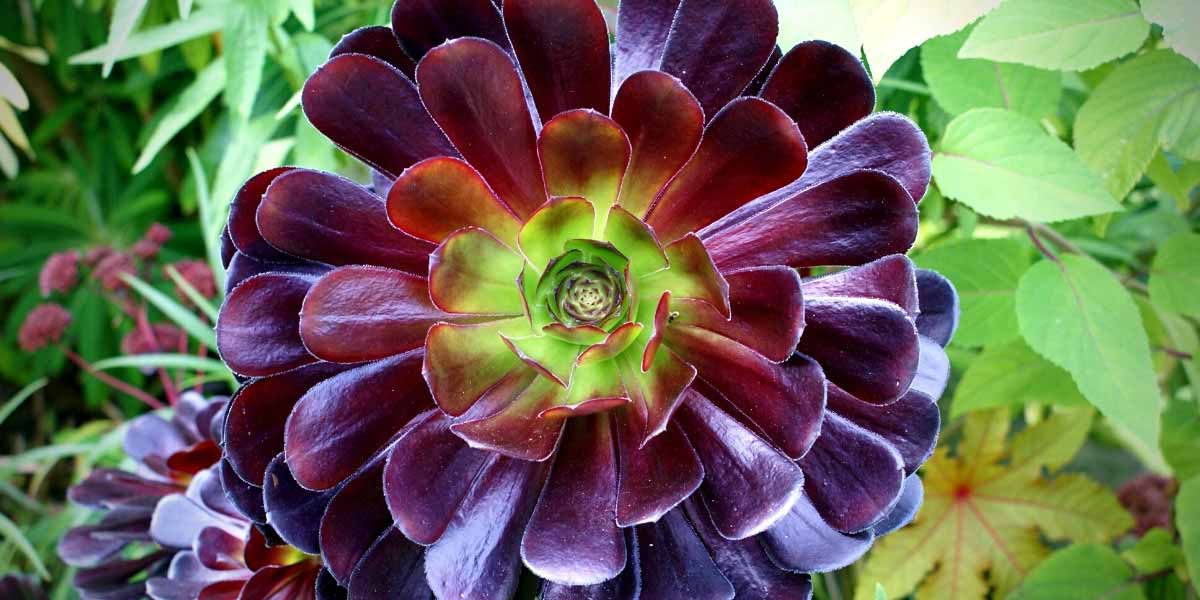
Maintenance
Like other succulent plants, Aeoniums require minimal maintenance. They should be watered moderately, as they are sensitive to excess moisture, which could cause their roots to rot. We recommend watering them about once a week from spring to autumn, allowing the soil to dry out between waterings. Also, remember to empty any excess water from the saucer. Reduce watering in winter: once a month will suffice. If possible, use rainwater, as tap water may be too hard for the Aeonium.
In spring, you can apply a little cactus and succulent fertiliser, once a month. This will provide the Aeonium with the nutrients it needs to support its growth and encourage flowering.
If you grow the Aeonium in a pot, we advise moving it outdoors in spring, once the risk of frost has passed, placing it on a balcony, windowsill, or terrace. This way, it can enjoy better light exposure in summer. Bring it back indoors in autumn, before the first cold spells, and place it in a bright spot, such as near a window. Ideally, keep it at a temperature of at least 10°C.
We recommend repotting the Aeonium every two to three years, preferably in spring.
Aeoniums are susceptible to mealybugs, especially when grown indoors. These pests can be identified by small white, cotton-like clusters and feed on the plant’s sap, weakening it and potentially leading to sooty mould. You can remove them using a cotton swab dipped in 90% alcohol or soapy water. For more advice and information, check out our guide “Mealybugs: Identification and Treatment”.
Multiplication
To propagate Aeonium, we recommend propagation by cuttings of leaves or stems.
Sowing
Aeonium seeds should be sown in spring.
- Prepare a pot by filling it with a well-draining substrate.
- Moisten the substrate.
- Scatter the seeds on the surface. As they are very fine, you can mix them with sand beforehand to make sowing easier.
- Spray a little water on the seeds.
- Place the pot in a sheltered spot, in a bright location but out of direct sunlight. The ideal temperature is between 19 and 24 °C.
Propagation by Cuttings
Aeoniums are easy to propagate from leaf or stem cuttings.
- For stem cuttings, choose a well-developed young plant and cut a stem bearing a rosette. For leaf cuttings, simply detach a few leaves from a young plant.
- Allow the stem or leaves to dry for a few days in the open air, until a callus forms over the cut area.
- Prepare a pot by filling it with a well-draining substrate, such as a mix of compost and coarse sand, or special cactus compost.
- For a stem cutting, make a hole in the substrate using a pencil, then plant the stem and lightly firm the substrate around it to ensure good contact. For a leaf cutting, simply place the leaves on the substrate without burying them.
- Water lightly.
- Place the pot in a sheltered spot.
For more tips and explanations, check out our tutorial “Propagating Cacti and Succulents”.
Association
As it thrives in mild climates, the Aeonium will integrate perfectly into a Mediterranean garden. Create a stunning warm and exotic atmosphere by pairing it with agaves, yuccas, cordylines, and opuntias, which, like the Aeonium, love warmth and well-drained, dry soils. You can easily showcase these plants by incorporating them into a rock garden or a raised bed bordered by a stone wall. To add height and volume, plant palm trees alongside them. Finally, introduce splashes of colour with the flowering of agapanthus, rockroses, lavenders, and helianthemums.
Explore our full range of perennials and Mediterranean bushes.
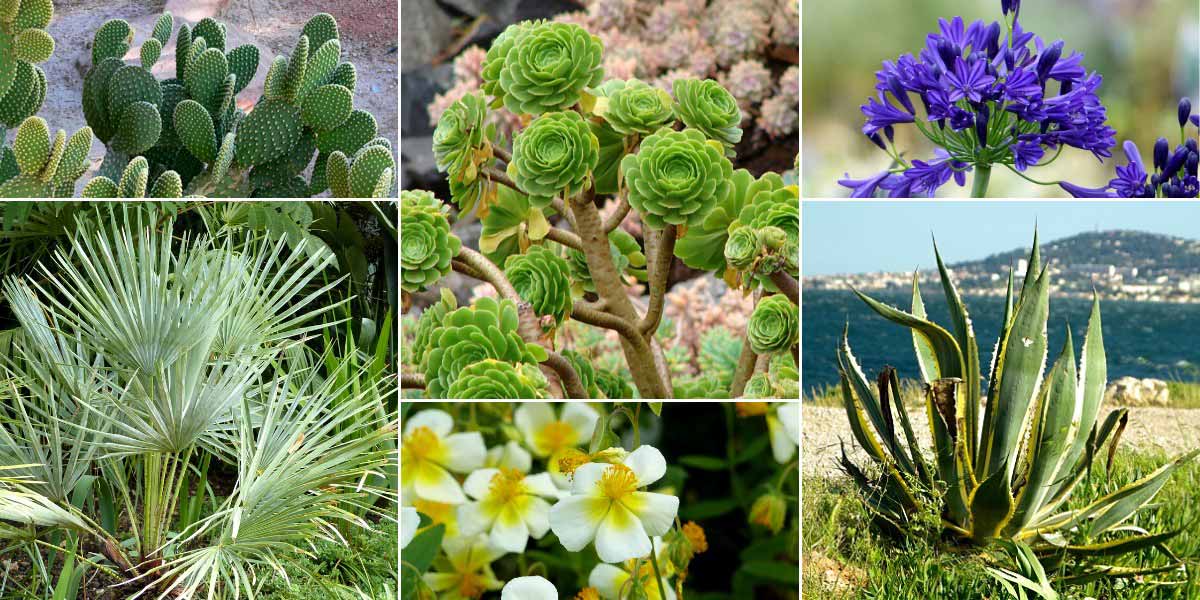
Opuntia microdasys (photo: Stan Shebs), Aeonium arboreum (photo: Forest and Kim Starr), Agapanthus ‘Royal Velvet’, Chamaerops humilis ‘Cerifera’, Helianthemum ‘Elfenbeinglanz’, and Agave americana ‘Variegata’
The Aeonium is also perfect for creating a potted arrangement alongside other succulent plants. This way, you can easily bring it indoors to protect it from the cold in winter. Choose a large terracotta pot, wide enough, and plant the Aeonium alongside Crassula ovata (discover the unique variety ‘Hobbit’), Echeverias, kalanchoes, and sedums. Also consider the Dyckia, a bromeliad with long, dentate, silvery-brown leaves. We recommend varying the shapes and colours to create an original composition resembling a miniature landscape. Add a layer of small gravel on the surface—it will insulate the plant collars from moisture while also being decorative!
Discover our full range of cacti and succulents.
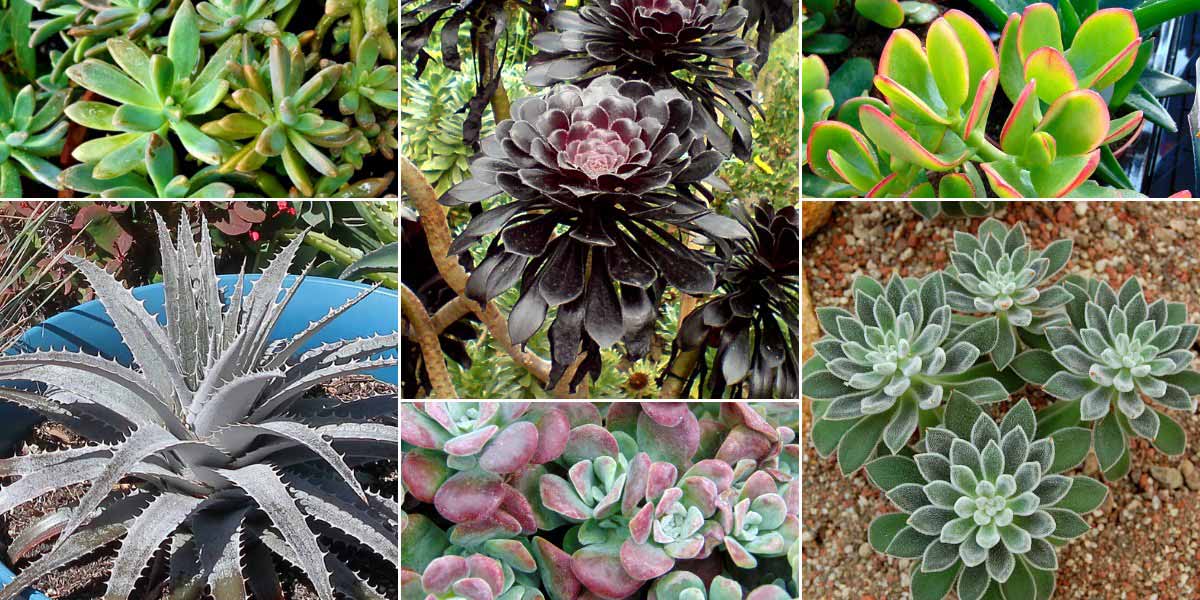
Pachyphytum (photo: Sabina Bajracharya), Aeonium, Crassula ovata ‘Sunset’, Dyckia, Sedum spathulifolium ‘Cape Blanco’, and Echeveria leucotricha
Also worth reading
-
- Discover our full range of cacti and succulents
- Feel free to check out our advice sheets “Which Cacti and Succulents for My Garden?” and “Creating a Dry Exotic Garden”
- Our tutorial: “Taking Cuttings from Cacti and Succulents”
- Subscribe!
- Contents































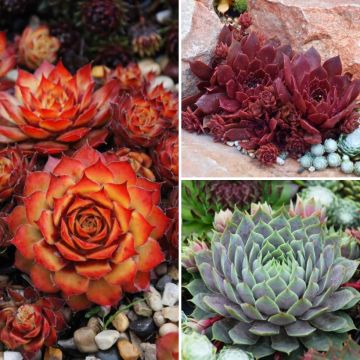
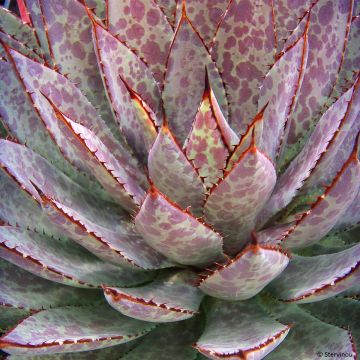

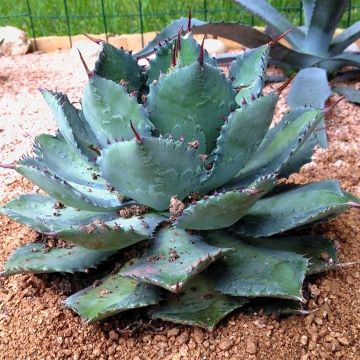
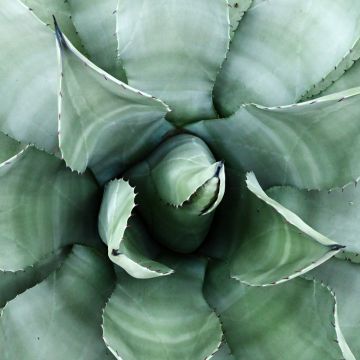
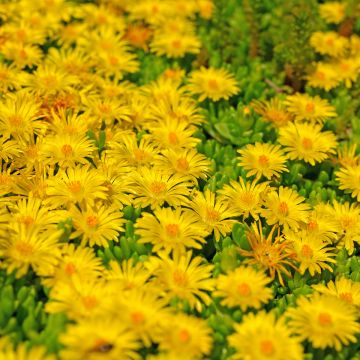
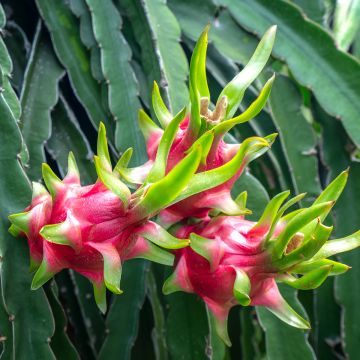
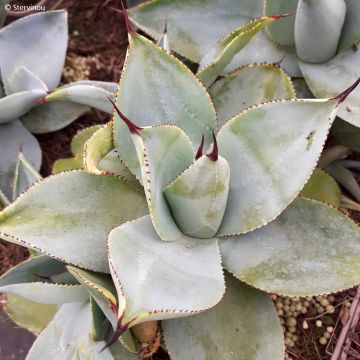
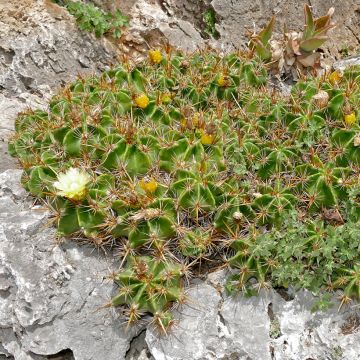
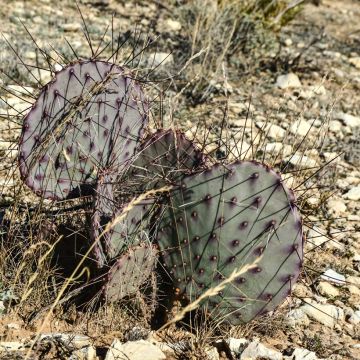
Comments